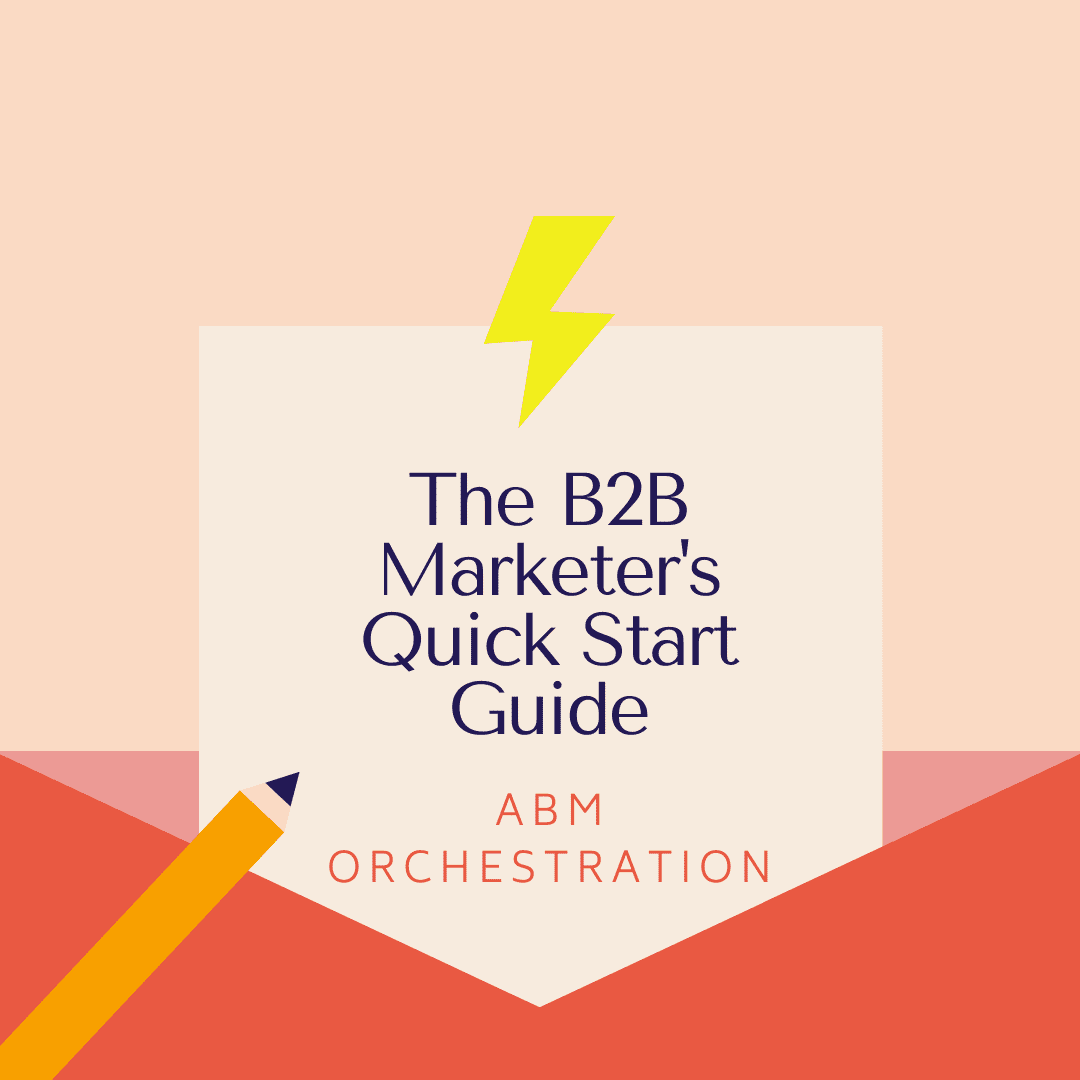The B2B Marketer’s Quick Start Guide: ABM Orchestration

By Brenna Lofquist, Senior Marketing Consultant at Heinz Marketing
In today’s digital technology landscape there are numerous platforms, tools and technologies at the disposal of every marketer—almost too many. My goal with the Quick Start Guide series is to provide you a quick synopsis of a martech solution category. For each category I’ll highlight a few platforms/tools, the pros and cons of each, benchmarks and additional resources. Without further ado…
Welcome to the sixth installment of The B2B Marketer’s Quick Start Guide. Today’s post is about ABM Orchestration. Check out the previous quick start guide posts on content amplification and sales automation.
Overview
Account-based marketing has been a popular topic over the last few years. To put it simply, ABM is a B2B marketing approach that targets accounts instead of individual contacts. In most cases, companies are using ABM to target their best-fit accounts, think quality over quantity. ABM really thrives from a highly-targeted, personalized approach.
In terms of tools and technology to aid with or facilitate ABM, there’re tons out there – it depends on where your organization is at and your goals. Some platforms are more robust whereas others help with a few key components and might rely on the integration of other systems to complete the strategy. With that said, I highly highly recommend you do plenty of research to figure out which platform is the best for your organization.
I hope this blog post serves as a starting point if you’re interested in ABM platforms or a great resource if you’re looking to brush up on a few platforms out there.
Personally, I’ve had experience with a few of these platforms at varying levels so I’ll leave you with a few things to think about and questions to ask yourself when you’re reviewing ABM platforms. This doesn’t have to be your criteria but could be some key differentiators between platforms.
- Account targeting functionality
- Does the platform leverage AI-based technology or data?
- Can the platform identify new accounts to target?
- If so, how do they identify these accounts?
- Is there an advertising component?
- Does the platform integrate with your other systems?
- Does the platform provide real-time insights?
- Is there automation functionality?
- I.e., the ability to route accounts from the ABM platform into your CRM system based on a certain stage or action
Now let’s dig into a few platforms shall we?
ABM Orchestration Platforms
DemandBase
- Features/functionality:
- Two solutions; ABX Cloud and DemandBase One (includes ABX Cloud)
- Advertise to your target accounts with the only DSP that delivers the precision and scale that B2B requires
- Deliver relevant experiences with website personalization to increase engagement and interaction
- Connect to third-party systems to trigger sales plays, orchestrate actions in MAS and extend your outreach
- Find expansion opportunities by monitoring intent and engagement by product line
- See how accounts are engaging over time with Heatmaps and the Deal Story
- Measure the impact and ROI of every interaction across Sales and Marketing with attribution
- Integrations: LinkedIn, Marketo, Drift, SalesLoft, HubSpot, Outreach, PathFactory, Salesforce, and more
- Reviews/rating:
- G2 Rating: 4.3 / 5
- Pros:
- A great tool to move your targeting from one-to-many to a one-to-one and do some true ABM tactics
- DemandBase offers great documentation in their resource center with trainings, certifications, and pre-packaged playbooks allowing you get proven ABM programs in-market quickly
- I like the ability to login anytime and see the current 1st and 3rd party trends associated to the key accounts we’re going after
- The platform is very easy to use and is backed by a world-class customer success team that will make sure you get the most out of the platform
- Cons:
- I wish there was a way to change engagement minute configurations for different parts of the organization
- The platform could improve the sync/integration with Salesforce. Most companies have poor CRM data hygiene, and DemandBase has struggled to sync data back to accounts in cases with duplicate accounts or accounts with inaccurate/incomplete information
- Sometimes it’s not easy to keep track of all your ABM lists and ad campaigns in one place
- Is more expensive than alternative solutions
6sense
-
- Features/functionality:
- Uncover anonymous and known buying signals on 1st- and 3rd-party websites so you know which accounts are in-market for your solutions today
- Turn anonymous buying signals into accurate account data – whether those buying signals are from known or unknown accounts
- Predict future outcomes – like ideal customers, account buying stage, and key buying center contacts – with historical and real-time behavioral data
- Integrate data silos while de-duping and normalizing records so your sales and marketing teams have a single source of rich, accurate account data
- Automatically reach key personas within the right accounts with our DSP or LinkedIn ads integration
- Empower sales reps to prioritize the best accounts and contacts by delivering insights within CRM on account engagement, buying teams, and key personas
- Integrations: HubSpot, Marketo, Outreach, SalesLoft, Sendoso, and more
- Reviews/rating:
- G2 Rating: 4.3 / 5
- Pros:
- Helps establish an accountable, data-driven ABM approach
- The account team and tech support were great to work with from the first kickoff, and had clear and specific instructions to get us set up
- The ability to drill down further to the prospects that have shown the most engagement so that I’m truly focusing on the warmest least
- 6sense has made my life 10 times easier and less hectic. Instead of going after every account I can now organize and work strategically to get better results
- Cons:
- The scoring tends to be unreliable, in my opinion, and the widget/platform could be more intuitive
- Sometimes the user interface is a bit confusing
- The Top Generic Keywords seem a little artificial sometimes or needs to be looking for more relevant keywords
- Sometimes there is confusion or overlap between accounts with organizations in multiple countries and is difficult to understand the engagement coming from the local account from that of other subsidiaries
- Features/functionality:
Terminus
-
- Features/functionality:
- An embedded CDP containing millions of businesses augmented by your first-party CRM and MAP data, firmographic data, behavioral and engagement data, intent data, psychographic data, and relationship data
- Multiple channels of engagement (ads, email, chat, and web) native to Terminus allow you to run coordinated multi-channel campaigns
- Analyze the impact of all your go-to-market activities from campaign-specific reporting all the way up to board-level dashboards with a user-friendly analytics and attribution engine
- Combine all your data in Terminus to create segments, orchestrate multi-channel campaigns, and measure your entire go-to-market program
- Integrations: Marketo, Salesforce, HubSpot, PathFactory, Bombora, Outreach, SalesLoft, and more
- Reviews/rating:
- G2 Rating: 4.4 / 5
- Pros:
- Terminus support gets back to you very quickly, you always know the status of your ticket and it feels like they are happy to help whenever you need it
- The technology is capable of targeting the same ideal group of customers across several digital channels, keeping your messaging in front of them consistently
- Terminus helps us have an integrated marketing solution. We are able to have a PPC strategy based on intent data that we are receiving from the Terminus platform
- The platform is very easy to use, especially for first-time users
- Segmenting lists and executing targeted programs is straightforward, and the platform allows you to see results in a number of ways
- Cons:
- Downsides are minimal. The Terminus team listens to their customers and is always looking for ways to improve their experience and resolve any issues/roadblocks promptly
- Some of the reporting features in chat could be improved
- ABM still requires some manual orchestration and reporting can be challenging
- Features/functionality:
Triblio
-
- Features/functionality:
- Triblio provides account-based marketing software to help marketers drive pipeline and revenue growth
- Scale multi-channel account-based campaigns as easily as email automation
- Execute targeted display advertising, dynamic web personalization, and intent-drive sales plays, all on one platform
- Mobilize your sales team with valuable insights to shorten sales cycles and accelerate deals
- Target large, strategic accounts with deep personalization online and offline
- Integrations: HubSpot, Salesforce, Mailchimp, Pardot, and more
- Reviews/rating:
- G2 Rating: 4.2 / 5
- Pros:
- We love the flexibility and control while managing handfuls of campaigns monthly. You have the power to manage everything at a detailed campaign level
- The data and level of granularity that we can get to is extremely valuable and running campaigns is really easy and simple to set up and continuously optimize
- The metrics are really helpful, and we love how we can set up MQAs and easily see what accounts are engaging with our website
- The interface is very easy to use. I love all the features the campaign builder, all the different reports and metric, the sales emails
- Cons:
- There are times when I can get a little lost in the platform when doing tasks like editing/creating campaigns. So some UI tweaks could probably help here
- I wish there was more documentation so I could troubleshoot and solve problems without involving customer support
- The user interface can be clunky to work with and sometimes requires a CSM to make edits for you on the back end
- Features/functionality:
To Sum it All Up
To reiterate, I always encourage you to check out these platforms for yourself, especially depending on the goals and objectives of your business. I haven’t even scratched the surface when it comes to the ABM platforms available so I’m interested to see if you have any you’d recommend? Let me know!
Next up: Marketing Automation






